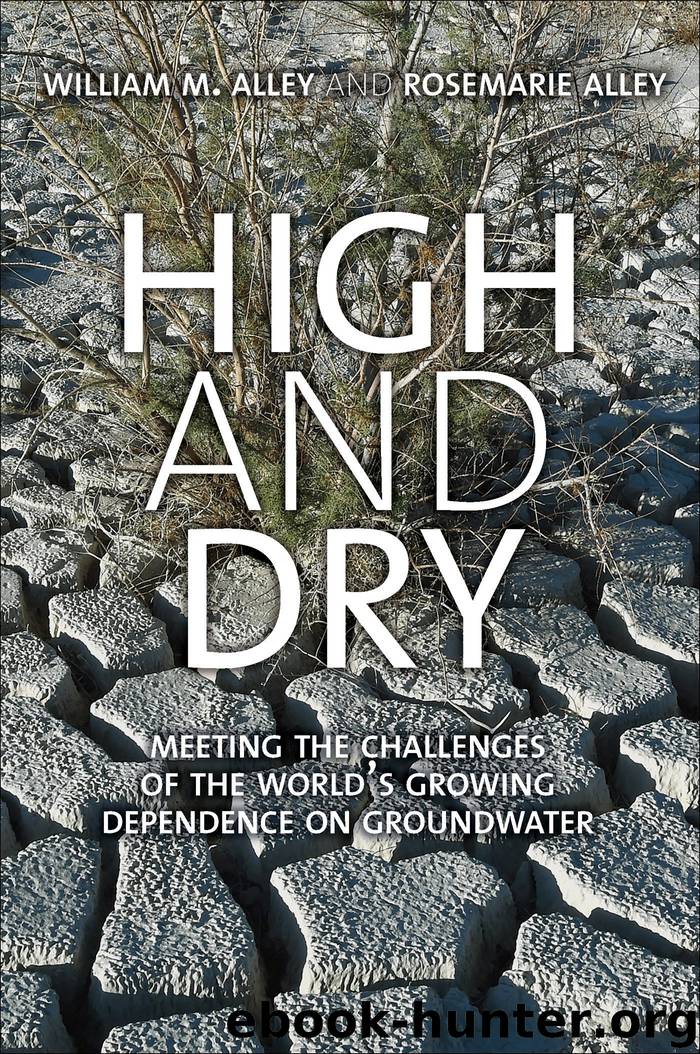High and Dry by William M. Alley

Author:William M. Alley
Language: eng
Format: epub
Publisher: Yale University Press
Published: 2017-04-10T04:00:00+00:00
9
That Sinking Feeling
Therein is the tragedy. Each man is locked into a system that compels him to increase his [use] without limit—in a world that is limited.
—Garrett Hardin
In 1939, Joe Poland was hired by the U.S. Geological Survey to study saltwater intrusion that was threatening public water supplies from Los Angeles to Orange County. Poland had just finished his master’s degree at Stanford, with his Ph.D. at the “ABD” (all but dissertation) stage. One of his first classes had been Professor Tolman’s course on groundwater geology, an entirely new field at the time. His main interest soon centered on land subsidence. During his years at Stanford, Poland worked with Tolman on the Santa Clara Valley (today’s Silicon Valley), where significant land subsidence was occurring. After eight years at Stanford, Poland was impatient to get out and do some field-based research. He’d get back to the dissertation later.1
After being hired by the USGS, Poland studied saltwater intrusion in the Long Beach area. His first move was to round up as many water and oil drilling logs as possible—a formidable task. Vast oil reserves had been discovered in the Los Angeles Basin. By 1930, California was producing nearly a quarter of the world’s oil. The Long Beach Oil Field included Signal Hill, one of the most productive fields on Earth. By the time Poland arrived in Long Beach, the entire area was a virtual forest of drilling rigs.
There was a lot more going on than drilling for oil. Long Beach was on its way to becoming the second busiest container port in the United States, and the Navy was expanding its submarine base into a full-scale naval operations base.
Two years into his research, Poland became involved in a developing crisis in the harbor area. Naval installations were showing unexpected, and considerable, structural damage. Foundations of some dry docks and ship building facilities were collapsing. Poland’s study of the area’s oil well logs pointed to the newly recognized phenomenon of land subsidence induced by pumping oil.
When oil executives learned of this young scientist pointing the finger at their operations, they called him in for a meeting. Without mincing words, they informed Poland that they were men of considerable power and political influence. He could lose his job if he continued his investigation in the harbor area. A few weeks later, a recalcitrant Joe Poland was called to Washington to give expert testimony about the damage to the harbor area and its possible causes. From the time he left California, an FBI agent accompanied him around the clock until he completed his testimony. The oil companies were found to be responsible for the damage to the naval installations. Nonetheless, production continued and land subsidence at Long Beach eventually reached twenty-nine feet (8.8 meters)—about the height of a three-story building. The subsidence was eventually halted in the 1950s by pumping seawater into the oil field.2
In 1949, the USGS opened a regional office in Sacramento and put Poland in charge. Over the next few years, he
Download
This site does not store any files on its server. We only index and link to content provided by other sites. Please contact the content providers to delete copyright contents if any and email us, we'll remove relevant links or contents immediately.
| Automotive | Engineering |
| Transportation |
Whiskies Galore by Ian Buxton(41530)
Introduction to Aircraft Design (Cambridge Aerospace Series) by John P. Fielding(32888)
Small Unmanned Fixed-wing Aircraft Design by Andrew J. Keane Andras Sobester James P. Scanlan & András Sóbester & James P. Scanlan(32573)
Craft Beer for the Homebrewer by Michael Agnew(17933)
Turbulence by E. J. Noyes(7700)
The Complete Stick Figure Physics Tutorials by Allen Sarah(7141)
Kaplan MCAT General Chemistry Review by Kaplan(6595)
The Thirst by Nesbo Jo(6437)
Bad Blood by John Carreyrou(6275)
Modelling of Convective Heat and Mass Transfer in Rotating Flows by Igor V. Shevchuk(6223)
Learning SQL by Alan Beaulieu(6035)
Weapons of Math Destruction by Cathy O'Neil(5829)
Man-made Catastrophes and Risk Information Concealment by Dmitry Chernov & Didier Sornette(5647)
Digital Minimalism by Cal Newport;(5389)
Life 3.0: Being Human in the Age of Artificial Intelligence by Tegmark Max(5184)
iGen by Jean M. Twenge(5161)
Secrets of Antigravity Propulsion: Tesla, UFOs, and Classified Aerospace Technology by Ph.D. Paul A. Laviolette(4992)
Design of Trajectory Optimization Approach for Space Maneuver Vehicle Skip Entry Problems by Runqi Chai & Al Savvaris & Antonios Tsourdos & Senchun Chai(4840)
Electronic Devices & Circuits by Jacob Millman & Christos C. Halkias(4748)
